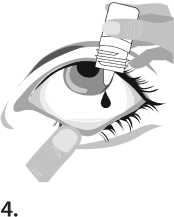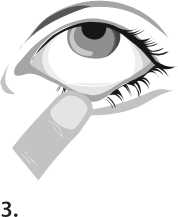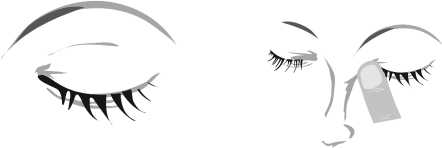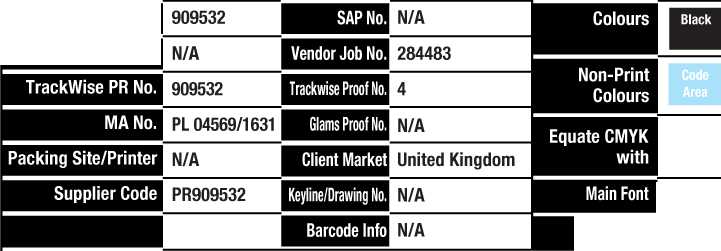Brimonidine Tartrate/Timolol 2 Mg/Ml + 5 Mg/Ml Eye Drops Solution

Package leaflet: Information for the patient
Brimonidine Tartrate/Timolol 2 mg/ml + 5 mg/ml Eye Drops Solution
Read all of this leaflet carefully before you
start using this medicine because it contains
important information for you.
• Keep this leaflet. You may need to read it again.
• If you have any further questions, ask your doctor or pharmacist.
• This medicine has been prescribed for you only. Do not pass it on to others. It may harm them, even if their signs of illness are the same as yours.
• If you get any side effects, talk to your doctor or pharmacist. This includes any possible side effects not listed in this leaflet. See section 4.
What is in this leaflet
1. What Brimonidine Tartrate/Timolol is and what it is used for
2. What you need to know before you use Brimonidine Tartrate/Timolol
3. How to use Brimonidine Tartrate/Timolol
4. Possible side effects
5. How to store Brimonidine Tartrate/Timolol
6. Contents of the pack and other information
1. What Brimonidine Tartrate/Timolol is and what it is used for
Brimonidine Tartrate/Timolol is an eye drop that is used to control glaucoma. It contains two different medicines (brimonidine and timolol) that both reduce high pressure in the eye. Brimonidine belongs to a group of medicines called alpha-2 adrenergic receptor agonists. Timolol belongs to a group of medicines called beta-blockers. Brimonidine Tartrate/Timolol is prescribed to reduce high pressure in the eye when beta-blocker eye drops used alone are not enough.
Your eye contains a clear, watery liquid that feeds the inside of the eye. Liquid is constantly being drained out of the eye and new liquid is made to replace this. If the liquid cannot drain out quickly enough, the pressure inside the eye builds up and could eventually damage your sight. Brimonidine Tartrate/Timolol works by reducing the production of liquid and increasing the amount of liquid that is drained. This reduces the pressure inside the eye whilst still continuing to feed the eye.
2. What you need to know before you use Brimonidine Tartrate/Timolol
Do not use Brimonidine Tartrate/Timolol:
• if you are allergic to brimonidine tartrate, timolol, beta-blockers or any of the other ingredients of this medicine (listed in section
6). Symptoms of an allergic reaction may include swelling of the face, lips and throat, wheeziness, feeling faint, shortness of breath, itching or redness around the eye
• if you have now or have had in the past respiratory problems such as asthma, severe chronic obstructive bronchitis (severe lung disease which may cause wheeziness, difficulty in breathing and/or long- standing cough)
• if you have heart problems such as low heart rate, heart failure, heart beat disorders (unless controlled by a pacemaker)
• if you are taking monoamine oxidase (MAO) inhibitors or certain other antidepressant drugs
Brimonidine Tartrate/Timolol should not be used in children less than 2 years old and should not usually be used in children aged 2 to 17.
If you think any of these points apply to you, do not use Brimonidine Tartrate/Timolol until you have talked again to your doctor.
Warnings and precautions
Talk to your doctor or pharmacist before using Brimonidine Tartrate/Timolol
• if you have now or have had in the past:
* coronary heart disease (symptoms can include chest pain or tightness, breathlessness or choking), heart failure, low blood pressure
* disturbances of heart rate such as slow heart beat
* breathing problems, asthma or chronic obstructive pulmonary disease
* poor blood circulation disease (such as Raynaud's disease or Raynaud's syndrome)
* diabetes as timolol may mask signs and symptoms of low blood sugar levels
* over activity of the thyroid gland as timolol may mask signs and symptoms
* kidney or liver problems
* tumour of the adrenal gland
* eye surgery to lower the pressure in your eye.
• if you suffer or have suffered from any allergy (e.g. hayfever, eczema) or a severe allergic reaction be aware that the usual dose of adrenaline used to control a severe reaction may need to be increased.
Tell the doctor before you have an operation that you are using Brimonidine Tartrate/Timolol, as the timolol may change effects of some medicines during anaesthesia.
Other medicines and Brimonidine Tartrate/Timolol
Brimonidine Tartrate/Timolol can affect or be affected by other medicines you are using, including other eye drops for the treatment of glaucoma.
Tell your doctor or pharmacist if you are taking, or have recently taken or might take any other medicines, including medicines for any condition, even if unrelated to your eye condition, including medicines obtained without a prescription.
There are a number of medicines which may interfere with Brimonidine Tartrate/Timolol, so it is particularly important to tell your doctor if you are taking:
• pain killers
• medicines to help you sleep or for anxiety
• medicines to treat high blood pressure (hypertension)
• medicines for heart conditions (for example an abnormal heartbeat) such as beta blockers, digoxin or quinidine (used to treat heart conditions and some types of malaria)
• medicines to treat diabetes or high blood sugar
• medicines for depression such as fluoxetine and paroxetine
• another eye drop used to lower high pressure in the eye (glaucoma)
• medicines to treat severe allergic reactions
• medicines that affect some of the hormones in your body, like adrenaline and dopamine
• medicines that affect the muscles in your blood vessels
• medicines to treat heartburn or stomach ulcers.
If the dose of any of your current medicines is changed or if you are regularly consuming alcohol you should tell your doctor.
If you are due to have an anaesthetic, you should tell the doctor or dentist that you are taking Brimonidine Tartrate/Timolol.
Pregnancy and breast-feeding
If you are pregnant or breast-feeding, think you may be pregnant or are planning to have a baby, ask your doctor or pharmacist for advice before taking this medicine.
Do not use Brimonidine Tartrate/Timolol if you are pregnant unless your doctor considers it necessary. Do not use Brimonidine Tartrate/Timolol if you are breast-feeding. Timolol may get into your milk. Ask your doctor for advice before taking any medicine during breast-feeding.
Driving and using machines
Brimonidine Tartrate/Timolol may cause drowsiness, tiredness or blurred vision in some patients. Do not drive or use any tools or machines until the symptoms have cleared. If you experience any problems, talk to your doctor.
Brimonidine Tartrate/Timolol contains benzalkonium chloride Contact lenses
• Do not use Brimonidine Tartrate/Timolol while your contact lenses are in your eyes. Wait at least 15 minutes after using Brimonidine Tartrate/ Timolol before putting your lenses back in.
• A preservative in Brimonidine Tartrate/Timolol (benzalkonium chloride) may cause eye irritation and is also known to discolour soft contact lenses.
3. How to use Brimonidine Tartrate/Timolol
Always use this medicine exactly as your doctor has told you. Check with your doctor or pharmacist if you are not sure.
Use in children and adolescents
Brimonidine Tartrate/Timolol must not be used in infants below 2 years of age. Brimonidine Tartrate/ Timolol should not usually be used in children and adolescents (from 2 to 17 years).
Use in adults, including older people
The recommended dose is one drop of Brimonidine Tartrate/Timolol, twice a day about 12 hours apart. Do not change the dose or stop taking it without speaking to your doctor.
If you have other eye drops as well as Brimonidine Tartrate/Timolol, leave at least 5 minutes between using Brimonidine Tartrate/Timolol and the other eye drops.
Instructions for use
You must not use the bottle if the tamper-proof seal on the bottle neck is broken before you first begin to use it.
Wash your hands before opening the bottle. Tilt your head back and look at the ceiling.
1. 2.


1. Gently pull down the lower eyelid until there is a small pocket.
2. Turn the bottle upside down and squeeze it to release one drop into each eye that needs treatment.
3. Let go of the lower lid, and close your eye.
4. Keep the eye closed and press your finger against the corner of your eye (the side where your eye meets your nose) for two minutes.
This helps to stop Brimonidine Tartrate/Timolol getting into the rest of the body.
If a drop misses your eye, try again.
To avoid contamination, do not let the tip of the bottle touch your eye or anything else. Put the screw-cap back on to close the bottle, straight after you have used it.
If you use more Brimonidine Tartrate/Timolol than you should
Adults
If you use more Brimonidine Tartrate/Timolol than you should, it is unlikely to cause you any harm.
Put your next drop in at the usual time. If you are worried, talk to your doctor or pharmacist.
Babies and children
Several cases of overdose have been reported in babies and children receiving brimonidine (one of the ingredients of Brimonidine Tartrate/Timolol) as part of medical treatment for glaucoma.
PR909532
Description

1/2
Page Count
Component Type
Affiliate Item Code
Superceded Affiliate Item Code
Brimonidine Tartrate Timolol Maleate 2 mg / ml,5 mg / ml 1 x 5 ml
Leaflet
Pharma Code
TBC
No. of colours
1

162 x 590 mm
Sign-offs
Myriad Pro
Dimensions
Body Text Size
10 pt
Min Text Size used
10 pt
Signs include sleepiness, floppiness, low body temperature, paleness and breathing difficulties. Should this happen, contact your doctor immediately.
Adults and children
If Brimonidine Tartrate/Timolol has been accidentally swallowed then you should contact your doctor immediately.
If you forget to use Brimonidine Tartrate/Timolol
If you forget to use Brimonidine Tartrate/Timolol, use a single drop in each eye that needs treatment as soon as you remember, and then go back to your regular routine. Do not take a double dose to make up for a forgotten dose.
If you stop using Brimonidine Tartrate/Timolol
Brimonidine Tartrate/Timolol should be used every day to work properly.
If you have any further questions on the use of this product, ask your doctor or pharmacist.
4. Possible side effects
Like all medicines, this medicine can cause side effects, although not everybody gets them.
If you experience any of the following side effects, please contact your doctor immediately:
• heart failure (eg. chest pain) or irregular heart rate
• increased or decreased heart rate or low blood pressure.
The following side effects may be seen with Brimonidine Tartrate/Timolol.
Affecting the eye
Very common (may affect more than 1 in 10 people):
• eye redness or burning.
Common (may affect up to 1 in 10 people):
• stinging or pain in the eye
• allergic reaction in the eye or on the skin around the eye
• small breaks in the surface of the eye (with or without inflammation)
• swelling, redness or inflammation of the eyelid
• irritation, or a feeling of something in the eye
• itching of the eye and eyelid
• follicles or white spots on the see through layer which covers the surface of the eye
• vision disturbance
• tearing
• eye dryness
• sticky eyes.
Uncommon (may affect up to 1 in 100 people):
• difficulty in seeing clearly
• swelling or inflammation of the see-through layer which covers the surface of the eye
• tired eyes
• sensitivity to light
• eyelid pain
• whitening of the see-through layer which covers the surface of the eyes
• swelling or areas of inflammation under the surface of the eye
• floaters in front of the eyes.
Not known (frequency cannot be estimated from the available data):
• blurred vision.
Affecting the body:
Common (may affect up to 1 in 10 people):
• high blood pressure
• depression
• sleepiness
• headache
• dry mouth
• general weakness.
Uncommon (may affect up to 1 in 100 people):
• heart failure
• irregular heart rate
• light-headedness
• fainting
• dry nose
• taste disturbance
• nausea
• diarrhea.
Not known (frequency cannot be estimated from the available data):
• increased or decreased heart rate
• low blood pressure
• face redness.
Some of these effects may be due to an allergy to any of the ingredients. Additional side effects have been seen with brimonidine or timolol and therefore may potentially occur with Brimonidine Tartrate/Timolol.
The following additional side effects have been seen with brimonidine:
• inflammation within eye, small pupils, difficulty sleeping cold-like symptoms shortness of breath, symptoms involving the stomach and digestion, general allergic reactions, skin reactions including redness, face swelling itching rash and widening of blood vessels.
Like other medicines applied into eyes,
Brimonidine Tartrate/Timolol is absorbed into the blood. Absorption of timolol, a beta blocker component of Brimonidine Tartrate/Timolol, may cause similar side effects as seen with "intravenous" and /or "oral" beta-blocking agents. Incidence of side effects after topical ophthalmic administration is lower than when medicines are for example, taken by mouth or injected. Listed side effects include reactions seen within the class of beta-blockers when used for treating eye conditions:
• generalised allergic reactions, including swelling beneath the skin (that can occur in areas such as the face and limbs, and can obstruct the airway which may cause difficulty swallowing or breathing), hives (or itchy rash), localised and generalised rash, itchiness, severe sudden life threatening allergic reaction
• low-blood glucose levels
• difficulty in sleeping (insomnia), nightmares, memory loss
• stroke, reduced blood supply to the brain, increased signs and symptoms of myasthenia gravis (muscle disorder), unusual sensations (like pins and needles)
• inflammation in the cornea, detachment of the layer below the retina that contains blood vessels following filtration surgery which may cause visual disturbances, decreased corneal sensitivity, corneal erosion (damage to the front layer of the eyeball), drooping of the upper eyelid (making the eye half closed), double vision
• chest pain, oedema (fluid build up), changes in the rhythm or speed of the heartbeat, a type of heart rhythm disorder, heart attack, heart failure
• Raynaud's phenomenon, cold hands and feet
• constriction of the airways in the lung (predominantly in patients with pre-existing disease) difficulty breathing, cough
• indigestion, abdominal pain, vomiting
• hair loss, skin rash with white silvery coloured appearance (psoriasiform rash) or worsening of psoriasis, skin rash
• muscle pain not caused by exercise
• sexual dysfunction, decreased libido
• muscle weakness/ti red ness.
Other side effects reported with eye drops containing phosphates:
In very rare cases, some patients with severe damage to the clear layer at the front of the eye (the cornea) have developed cloudy patches on the cornea due to calcium build up during treatment.
Reporting of side effects
If you get any side effects, talk to your doctor or pharmacist. This includes any possible side effects not listed in this leaflet. You can also report side effects directly via the Yellow Card Scheme at: www.mhra.gov.uk/yellowcard. By reporting side effects, you can help provide more information on the safety of this medicine.
5. How to store Brimonidine Tartrate/Timolol
Keep this medicine out of the sight and reach of children.
Keep the bottle in the outer carton to protect it from light. Do not store above 25°C.
You should only use one bottle at a time.
Do not use this medicine after the expiry date which is stated on the label of the bottle and the carton after EXP. The expiry date refers to the last day of that month.
If the medicine becomes discoloured or shows any other signs of deterioration, consult your pharmacist who will tell you what to do.
You must throw away the bottle 4 weeks after you first opened it, even if there are still some drops left. This will help to prevent infections. To help you remember, write down the date that you opened it in the space on the carton.
Do not throw away any medicines via wastewater or household waste. Ask your pharmacist how to throw away medicines you no longer use. These measures will help to protect the environment.
6. Contents of the pack and other information
What Brimonidine Tartrate/Timolol contains
The active substances are brimonidine tartrate and timolol maleate. Each 1 ml of solution contains
2 mg of brimonidine tartrate and timolol maleate equivalent to 5 mg of timolol.
The other ingredients are benzalkonium chloride (a preservative), sodium phosphate monobasic monohydrate, sodium phosphate dibasic heptahydrate and water for injection.
Small amounts of hydrochloric acid or sodium hydroxide may be added to bring the solution to the correct pH (a measure of the acidity or alkalinity of the solution).
What Brimonidine Tartrate/Timolol looks like and contents of the pack
Brimonidine Tartrate/Timolol is a clear, greenish-yellow solution in a pack containing either 1,
3 or 6 plastic bottles each with a cap. Each bottle contains 5 ml solution.
Not all pack sizes may be marketed.
Marketing Authorisation Holder
Mylan, Potters Bar, Hertfordshire, EN6 1TL,
United Kingdom
Manufacturer
Combino Pharm (Malta) Ltd., HF 60 Hal Far Industrial Estate, Hal Far BBG 3000, Malta
This leaflet was last revised in 08/2016
909532
PR909532

Description
Component Type
Affiliate Item Code
Superceded Affiliate Item Code
TrackWise PR No.
MA No.
Packing Site/Printer
Supplier Code
|
Brimonidine Tartrate Timolol Maleate 2 mg / ml,5 mg / ml 1 x 5 ml | ||
|
Leaflet |
Pharma Code |
TBC |
|
909532 |
SAP No. |
N/A |
|
N/A |
Vendor Job No. |
284483 |
|
909532 |
Trackwise Proof No. |
4 |
|
PL 04569/1631 |
Glams Proof No. |
N/A |
|
N/A |
Client Market |
United Kingdom |
|
PR909532 |
Keyline/DrawingNo. |
N/A |
|
Barcode Info |
N/A | |
No. of colours
Colours Black
Non-Print Code
Colours Area
Equate CMYK with
Main Font
Dimensions
1
Page Count
2/2
Myriad Pro
Body Text Size
10 pt
162 x 590 mm
Min Text Size used
10 pt
Sign-offs
v1/May 2015